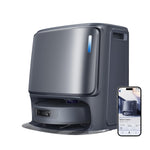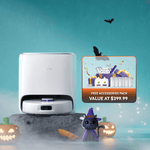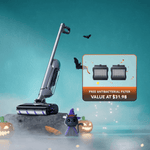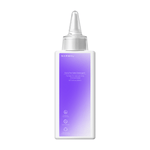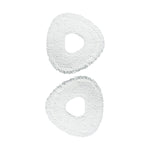Choosing between a round and square robot vacuum isn’t just about shape—it’s about how well it fits your home’s layout and cleaning needs. Round vacuums are known for their agility in tight spaces, while square or D-shaped models excel at reaching corners and along edges. But which one is truly better?
In this guide, we start with a side-by-side comparison of round vs square robot vacuums, covering cleaning efficiency, navigation, coverage, size, battery life, and more. We then look at the specific pros and cons of each design to help you understand where each type performs best. Finally, we offer advice tailored to Australian home layouts, from open-plan spaces to edge-heavy rooms, so you can confidently choose the right vacuum for your space.
Whether you're focused on convenience, performance, or home compatibility, this guide breaks down everything you need to know before buying.
Comparing Round vs. Square Robot Vacuums

Cleaning Efficiency
The cleaning efficiency of an automatic vacuum is crucial. Round vacuums typically come with rotating brushes and mop pads that excel at picking up debris and mopping stains on various surfaces.
Square vacuums tend to have a more direct path of vacuuming and mopping. This leads to better cleaning of corners and along edges. The shape of the vacuum can significantly impact how well it covers an area.
Square models often outperform their round counterparts in corner cleaning. However, advanced round-shaped models, such as Narwal Freo X Ultra, employ Reuleaux Triangular Mops mopping with 12N downward pressure at 180 RPM rotating speed to clean corners and edges more effectively.
Design and Navigation
Round and square automatic vacuums offer distinct designs that impact their navigation capabilities. Round vacuums often have a circular design. It enables smooth navigation around obstacles. Their rounded edges prevent them from getting stuck in tight corners.
On the other hand, square vacuums boast edges that allow them to clean corners more efficiently. This design can result in a more thorough cleaning experience.
Narwal models, such as Narwal Freo X Ultra and Narwal Freo X Plus, boast an advanced Tri-Laser obstacle avoidance technology, a combination of structured light, infrared, and ultrasonic sensors. This further enhances their strong flexibility with the round-shaped design.

Coverage Area
Coverage area is another important factor. Round vacuums are known for their ability to navigate larger spaces with ease, thanks to their all-direction movement. They can move around obstacles and furniture without much hassle. In contrast, square vacuums might face challenges in open spaces but excel in confined areas. Their shape allows them to access and clean spaces that round vacuums might miss. This makes them a better choice for smaller, cluttered rooms.
Size and Storage
Size and storage considerations are vital for many homeowners. Round vacuums are generally more compact, making them easier to store when not in use. Their smaller size also allows them to fit under low furniture, and it ensures those areas are cleaned. Square vacuums, while potentially bulkier, often come with larger dustbins and more storage capacity for dirt and debris. It helps reduce the frequency of emptying the bin.

Battery Life and Performance
Battery life and overall performance are critical aspects to consider. Round vacuums often come with longer battery life. That’s why they have extended cleaning sessions. They can clean larger areas on a single charge, which is ideal for bigger homes. Square vacuums, however, might have shorter battery life but compensate with more powerful suction and better performance in specific areas. The choice between the two may depend on the size of your home and the specific cleaning needs.

Price and Availability
Price and availability can vary significantly between round and square automatic vacuums. Generally, round vacuums are more widely available and come in a range of prices, from budget-friendly options to high-end models. Square vacuums might be less common and often sit at a higher price point due to their advanced features and design. It’s essential to consider your budget and the availability of models in your region before making a decision.
Maintenance and Durability
Maintenance and durability are important for the long-term use of your automatic vacuum. Round vacuums tend to have simpler designs, which means fewer parts to maintain and replace. They are often built to withstand frequent use and have a reputation for durability. Square vacuums might require more maintenance with their more complex design. But they are usually built with high-quality materials that ensure longevity. Consider how much time and effort you’re willing to invest in maintenance when choosing between the two.
Noise Level
Noise level is a common concern for many users. Round vacuums typically operate more quietly. They are a better choice for homes where noise is a consideration. This is particularly important if you plan to run the vacuum while you’re at home or during nighttime hours. Square vacuums might produce more noise due to their powerful suction and more robust motors. If noise is a significant factor for you, it’s worth testing the vacuums before making a purchase.
Pros and Cons of Round Robot Vacuums

Round robot vacuums are good at moving around furniture and obstacles, handling tight turns, and navigating complex layouts with ease. They are common in the market, so they offer a wide range of models with different functions. You could also choose the robots at various price points. Their design, with simpler access to brushes and wheels, makes them easier to clean and maintain.
However, they might struggle to clean corners due to their shape, making it difficult to reach edges effectively. That's why more and more round robot vacuums employ specially designed side brushes. Some of them, like Narwal Freo X Ultra, even develop technologies such as Smart EdgeSwing to counter the limitations. Round vacuums also tend to have smaller dustbins, which means you’ll need to empty them more often.
Pros and Cons of Square Robot Vacuums

Square robot vacuums are good at cleaning corners and edges. Their shape lets them get closer to walls and into tight spaces that round vacuums might miss. They usually have larger dustbins, so they can hold more debris before you need to empty them. Many square vacuums also come with advanced navigation systems, helping them clean your home more efficiently.
However, their shape can make it harder for them to move around furniture and other obstacles. They might not behave well when facing tight turns and complex layouts. Plus, there are fewer square robot vacuums available compared to round ones, so you have fewer models and price options to choose from.
Choosing the Right Robot Vacuum for Australian Homes
Australian homes often feature open-plan layouts, timber floors, and minimal carpet. Whether you live in a compact city apartment or a spacious suburban house, your floor plan and cleaning needs will help determine if a round or square robot vacuum is the better fit. Let’s explore key considerations like layout, cleaning habits, dustbin size, and smart features to help you make the right choice.
Consider Your Home Layout
If your home has lots of furniture and tight spaces, go for a round robot vacuum. It moves around obstacles easily. However, a square vacuum might be better if your home has more open areas and you need a vacuum that can clean corners well. It can get closer to walls and into corners for a thorough clean.
[cta:narwal-freo-x-ultra-robot-vacuum-mop]
Think About Cleaning Needs
Are you looking for general cleaning that’s easy to manage? Round vacuums are great for that. However, if dirt often collects in corners and along edges, a square vacuum might be more effective as it’s designed to handle those tricky spots better.
Evaluate Dustbin Capacity
Do you find emptying the dustbin often a hassle? Square vacuums typically have larger dustbins, meaning you won’t have to empty them as often. Round vacuums usually have smaller dustbins, so you’ll need to empty them more frequently. This can be annoying for larger homes.
Check for Advanced Features
Do you want modern features like mapping, smartphone control, and automatic dirt disposal? Many round vacuums come with these features. That gives you lots of options. Square vacuums also come with advanced tech and great features, though they are fewer in number.
|
Feature |
Round Robot Vacuum |
Square (D-Shaped) Robot Vacuum |
|
Corner Cleaning |
May struggle; relies on side brushes |
Designed to reach corners more effectively |
|
Navigation |
Great around furniture and tight spaces |
May get stuck in complex layouts |
|
Dustbin Size |
Usually smaller, needs frequent emptying |
Typically larger, less frequent emptying |
|
Model Availability |
Wide range of brands and prices |
Fewer models, often more premium |
|
Design Suitability |
Ideal for open, obstacle-heavy areas |
Best for edge-focused cleaning needs |
[cta:narwal-freo-x-plus-robot-vacuum-and-mop]
Do square or D-shaped vacuums clean corners better than round ones?
Yes, square or D-shaped robot vacuums are specifically designed to reach into corners and along edges. Their flat front edges allow closer contact with walls, which improves overall edge cleaning compared to round vacuums.
Why are most robot vacuums round instead of square?
Most robot vacuums are round because the shape makes it easier to navigate tight spaces and avoid obstacles. It's also simpler for manufacturers to design efficient, stable navigation with a circular frame.
Why are most robot vacuum cleaners circular in shape?
Most robot vacuum cleaners are circular because this shape allows for better maneuverability and navigation around furniture and obstacles. The round design makes it easier for the vacuum to move smoothly and avoid getting stuck.
Why are robot vacuums not square?
Robot vacuums are not commonly square because the round shape is more efficient for navigating tight spaces and avoiding obstacles. Square vacuums, while better at cleaning corners, can struggle with maneuverability in complex layouts.
Do robot vacuums miss corners?
Round robot vacuums can miss corners due to their shape. However, many models come with side brushes designed to help clean edges and corners more effectively. Square vacuums are specifically designed to address this issue and are better at this aspect. But even the best robot will miss some spots, and it's less of the product's fault than anything else.

































